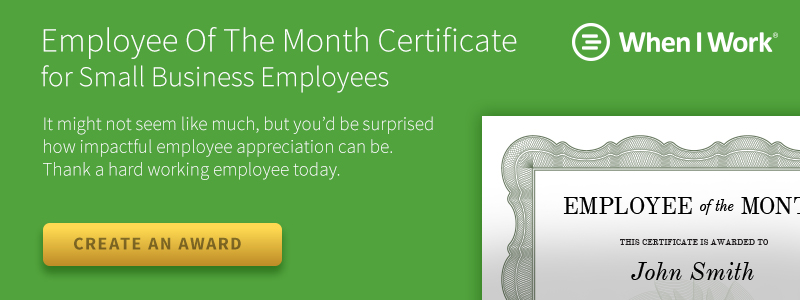Using Employee Recognition to Prevent Workers From Quitting
Try When I Work for free
One of the worst feelings a manager can have is that sudden cold dread when a top-performing employee gives their two weeks’ notice. And that feeling is justified — turnover is expensive. TalentWise found out just how expensive:
- When employees leave, they take 70% of their knowledge with them
- Replacing an employee costs up to 150% of the annual salary associated with that position
Now multiply those costs for each employee you lose in one year. It becomes pretty clear that keeping your employees is one of the most important investments you can make in your company. But what’s the best way to do it? Sky-high salaries? Fancy offices with a window view?
There’s one very effective — and inexpensive — method: employee recognition.
The Importance of “Thank You”
It might seem too good to be true that something as simple as recognizing your employees can be so important to job satisfaction. But TINYpulse’s internal research of thousands of employees found a strong correlation between how valued people feel and the likelihood that they’d reapply to their current job. And Globoforce found that 55% of employees are willing to quit their jobs to join a company that clearly recognizes its workers.
Simply put, feeling appreciated makes employees happy. Compensation and titles are good rewards, but so is the affirmation that they’re important to the company. And the great thing for you is that it costs nothing to say “thank you.”
Staying Steady Through Changes
Geeks2U is an example of the power of recognition. This Australia-based company was going through a growth spurt, and they wanted to boost employee morale during this time of upheaval. Their solution was TINYpulse, an employee survey tool with a built-in virtual employee recognition feature.
“Our experience has been that the ‘virtual pat on the back’ between colleagues is invaluable,” explains Strategic Planning Manager Michael Hancock. “Employees no longer receive positive feedback from just their manager but now their coworkers too, and it’s had a tremendous effect on the team as a whole.”
Change is a vulnerable time for an organization, and employees can head for the door in the midst of uncertainty. But Hancock observed that the peer-driven recognition helped bring the team closer together, and their workplace satisfaction stayed strong.
Making Recognition Part of Your Culture
As Geeks2U demonstrated, employee recognition has evolved from the traditional supervisor-subordinate method. And it’s no wonder — that method is failing. Consider these results from our recent Employee Engagement & Organizational Culture report:
- 30% of employees haven’t received recognition from their boss in the past two weeks
- 79% of employees don’t feel strongly valued at work
Turning to peer recognition is a wonderful way of crowdsourcing appreciation. People want to thank their coworkers for the work they do. And employees can feel appreciated without the responsibility all falling on company leaders.
To make peer recognition part of your culture, look for a tool with these features:
- Easy: Don’t make employees fill out long nomination forms to recognize their peers. Go for a digital tool that they can access on their computers and mobile devices.
- Available: Not everyone has time to give someone a pat on the back during the workday. A tool that’s available after-hours lets people say “thank you” whenever it’s convenient.
- Public: Everyone wants to brag a little! Make sure you can share recognition with the rest of the workforce so the whole company knows the great deeds their coworkers do.
Employee recognition can’t be underestimated. Making people feel valued for the time and effort they put in can do wonders for happiness and retention in your company.







